Wood Storks (Mycteria americana) are large wading birds known for their unique appearance.
With oval-shaped bodies, hunched posture, downcurved bills, and naked heads and necks, they stand out in tropical and subtropical forested wetland habitats. They are primarily piscivores and locate prey using touch.
On this page
Identification
Wood Storks are big wading birds with oval-shaped bodies, long legs, long necks, and long downcurved bills. They grow up to 33-45 inches tall and have a wingspan of 55-71 inches. You can recognize them by their hunched posture.
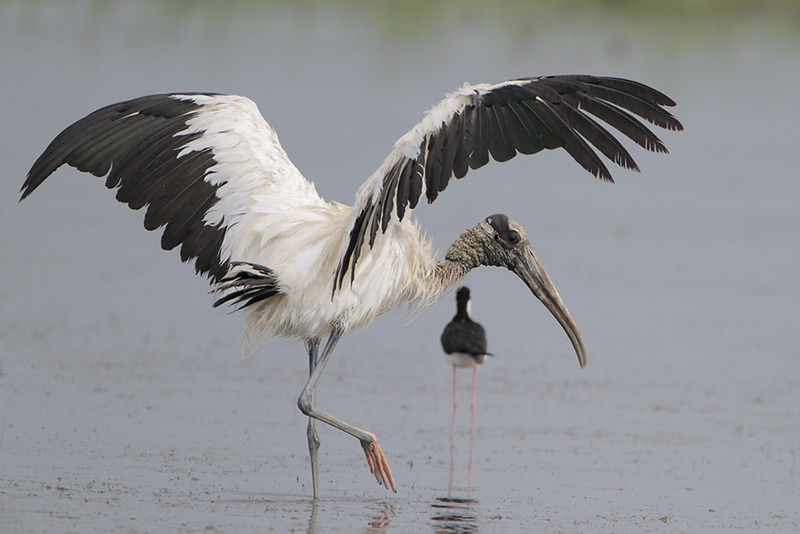
Wood Stork
Both male and female adult Wood Storks have predominantly white plumage with black flight feathers and tails that are best seen when they’re flying. Their featherless and scaly heads are dark gray or black and their bills and long legs are also black. When in flight, they keep their neck and legs extended.
Hatchlings are covered in gray, which turns to white down in 10 days. Juvenile Wood Storks are quite similar to adults but appear dusky and have feathered heads and their shorter bill is pale. When they fledge, their plumage turns white.
Related: Ugly (or unfortunate-looking) species
Wood Storks are quiet birds. During courtship, you can hear them snapping and clattering their bills and the nestlings can make loud nasal sounds but that’s about it.
Food
Wood Storks are primarily carnivorous, preferring fish and aquatic invertebrates, such as minnows, killifish, and mullet. They also consume crayfish, crabs, aquatic insects, sometimes frogs, rodents, seeds, and some plant material.
Wood Storks use various foraging techniques while walking slowly through wetlands.
They submerge their bills in the water, feeling for prey, and may also use their feet to stir up the water or flick their wings to startle potential catch. When they feel something, they snap their bills shut to swallow the captured creature whole.
Recent discoveries have shown that Wood Storks also venture out at night from their roosts to catch prey during low tides. This gives them an advantage over other big wading birds.
Nesting and Eggs
These wading birds are monogamous and often mate for life. They are colonial nesters and return to the same nest site each breeding season.
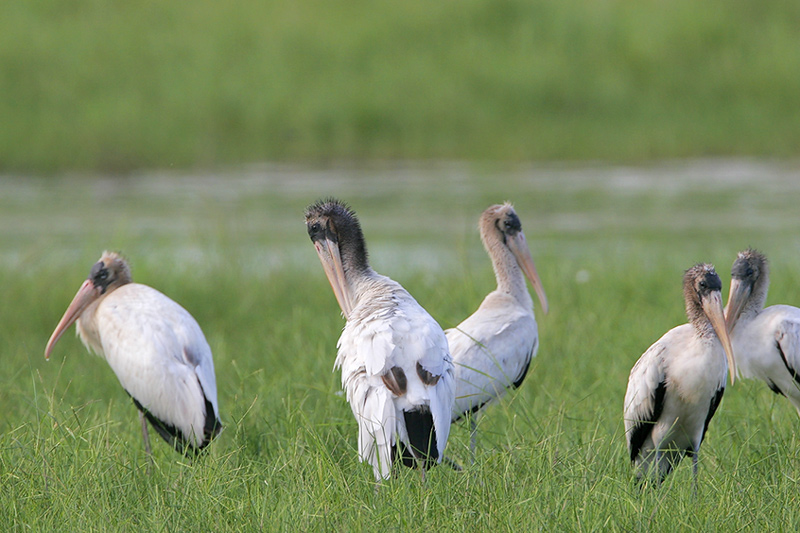
Wood Stork
Wood Storks nest in trees situated above standing water. They build their nests on a horizontal tree limb, with the height of the site varying depending on the breeding habitat.
In mangroves, the nests are usually around 10-15 feet above the ground, whereas in cypress swamps, they can be as high or even higher than 80 feet above the ground.
The nest itself is a large, about 3-5 feet wide structure made of sticks, lined with greenery, and eventually covered with bird excrement.
The male brings most of the materials, whereas the female does most of the building.
Wood Storks have a single brood per year, and some years they may not attempt to nest at all. The clutch consists of 1-5, usually 3-4 whitish eggs, which can be up to 3 inches long and 2 inches wide. Incubation lasts for 28-32 days with parents taking turns incubating.
Both parents feed the nestlings, with one typically guarding the young during the first few weeks, since unguarded nests may be attacked by unmated storks. The younglings fledge in 7-8 weeks but return to the nest until they’re about 11 weeks old.
Current Situation
Wood Stork’s range covers most of South America but extends through Central America to North America as well. They are year-round residents in Florida, the Caribbean, and South America. Breeding populations in the United States migrate southward for the winter.
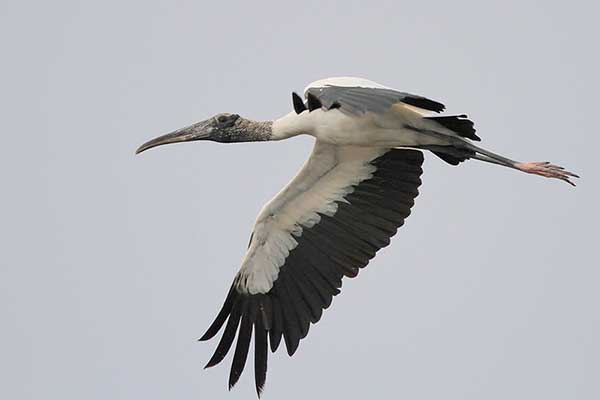
Wood Storks inhabit various subtropical and tropical forested wetland habitats both near fresh and brackish water. They can be found in cypress swamps, marshes, lagoons, ponds, mangroves, streams, and other places with fluctuating water levels.
This species is listed as of least concern on the IUCN Red List. However, its population is decreasing. Wood Storks are very sensitive to anything that changes the water levels. If water levels fall, the storks may choose not to nest that year and if they do, the nests and nestlings are at a higher risk of predation.
Facts
- Wood Storks were previously known under a different name – the wood ibis.
- During hotter times of the day, nestlings are at risk of overheating. To prevent that, their parents regurgitate water over the young and sometimes spread their wings to block the sun and cool them off.
- The bill-snapping reflex of Wood Storks is remarkably swift, ranking among the fastest reflexes observed in vertebrates, with a remarkable speed of approximately 25 milliseconds. Compare this to the time it takes for a human to blink their eyes – about 100-400 milliseconds.
- Wood Storks form colonies and construct their nests in trees surrounded by water, which provides a natural barrier against potential land predators. Interestingly, alligators play an unexpected role as guard dogs for the nestlings that don’t fall into the water and turn into gator snacks by hunting ground predators that might otherwise pose a threat to them.
Similar Species
Wood Storks have two similar species – the White Ibis and the American White Pelican. Read on to learn how to tell the difference!
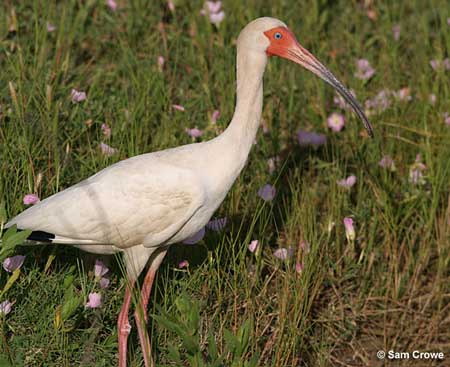
white ibis
While the two are somewhat similar, the White Ibis is smaller than the Wood Stork and only has black on its wingtips. Otherwise, it has pure white plumage.
White Ibis also has a red face and legs and its neck is feathered, unlike the Wood Stork which has a bare dark neck and black skin.
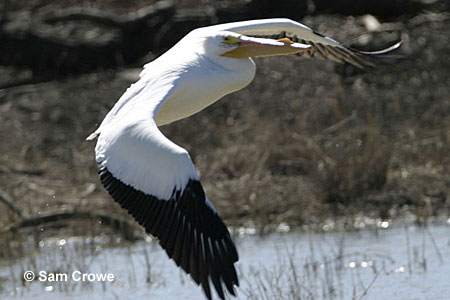
american white pelican
Their plumage pattern is rather similar, but the black on the American White Pelican’s wings is not as extensive, and it also has a feathered head and neck.
American White Pelicans have a yellow and straight bill instead of a black and downcurved one.
In flight, they keep their necks tucked in and their legs aren’t trailing behind their tails, whereas the Wood Stork keeps its neck straight and has legs trailing behind its tail.
Frequently Asked Questions
Are Wood Storks rare?
Overall, Wood Storks are not rare. However, in the United States, they are listed as threatened due to their low numbers.
How big can Wood Storks get?
Wood Storks can get as big as 3 feet tall and have a wingspan as wide as 5 feet. They’re one of the largest wading birds in North America.
Can a Wood Stork fly?
Wood Storks can fly. They do so with slow wingbeats and are often seen soaring high in the sky.
Are storks friendly?
Wood Storks are not friendly, per se, but they’re not aggressive either. They are shy creatures that may grow accustomed to human presence.

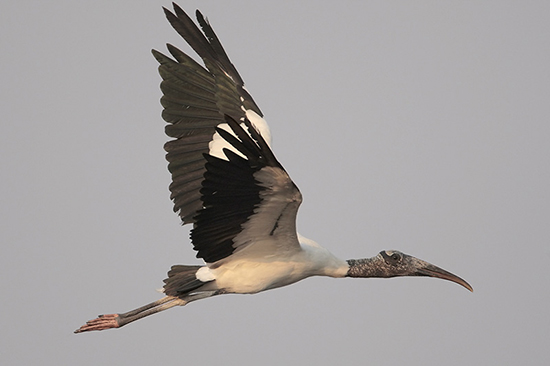
Susan Picciano
Thursday 28th of September 2023
I saw one in Pembroke Pines FL!!! I couldn't believe it! In fact, I had no idea what it was bc it was huge! I mean HUGE! It stood still as I walked by but it watched me!! Not sure where its mate was but sure it was near by. It was a beautiful bird!
Patrick O'Donnell
Thursday 28th of September 2023
@Susan- What a great sighting! Florida is the best place to see Wood Storks in the USA. Keep watching and please share more of your sightings with us.